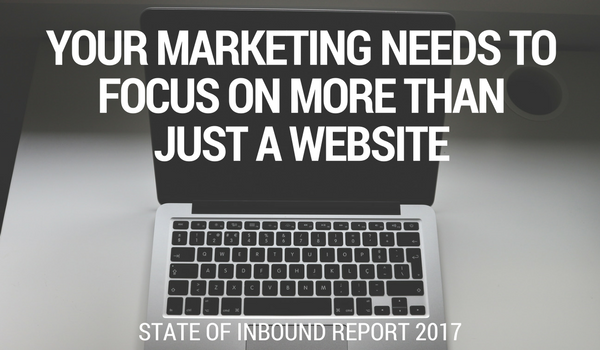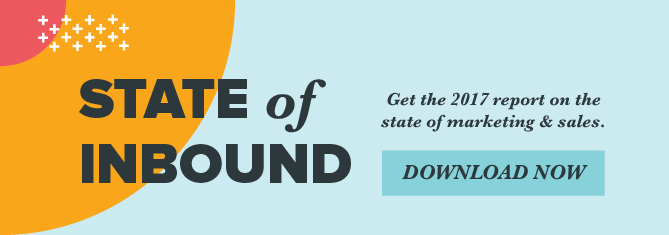
Last week, HubSpot released its annual State of Inbound report. Every year, HubSpot surveys companies across the globe about their marketing and sales efforts in an attempt to understand the state of marketing, and inbound marketing specifically. A lot of information is compiled into this report, which you can read here.
Companies that seem satisfied that they’ve created a website and think that’s all that’s needed to survive in the digital landscape are wrong. As the State of Inbound report states, “Our respondents believe that having a website and blog is no longer enough to attract the attention of their buyers.”
Fifty-five percent of marketers say they prioritize growing traffic to their company’s website. At the same time, 63% of companies say their top marketing challenge is generating traffic and leads. With the ever-changing digital landscape, it can be hard to know how to engage your audience and bring them back to your website.
While you can make efforts to improve the SEO of your site to draw an audience in organically, it’s also important to have other platforms pointing back to your website. These efforts, like all marketing efforts, should be done with purpose and provide relevant information to the audience you’re trying to reach—you don’t need to target the world. Here are some emerging trends from the State of Inbound report to consider when planning your marketing strategy.
The Disruptors
The State of Inbound report mentioned what it called three disruptors: video, messaging apps, and artificial intelligence and virtual reality. These tactics can seem unrelated to marketing and sales, especially if a company’s focus has solely been on having and maintaining a website. For companies that have more of a well-rounded strategy that includes social and traditional media, the trend towards these tactics might not appear so random. Either way, let’s take a look at these disruptors and how they can be successful in leading consumers back to your website.
Video
Video has been a popular way to communicate a company’s ideas for a long time. The ease of use that comes with uploading a video to YouTube or Vimeo allows anyone to share their ideas with the world. With the rise of live-streaming, whether on YouTube or Facebook, the demand for video is quite high. What sets one video apart from other is content and quality of the video.
One brand we’ve seen use Facebook live well is the A.V. Club. This pop culture website uses Facebook live to host TV-quality shows in the moment with live panels that can talk about the latest episode of the Bachelor or the week’s newest movies. And these live videos stay a part of the timeline even after the live segment is over.
Messaging
A constant disruptor is social media. Companies and brands have acclimated to Facebook and Twitter becoming an essential part of a marketing plan, but as new social media platforms come and go, it can be hard to know if any new platform has longevity. The State of Inbound report showed an increase in usage of messaging apps like WhatsApp, SnapChat, or Facebook’s Messenger. It’s important for brands to know which platforms to leverage as a marketing tool and which to use internally to enhance communication.
Hellman’s launched a campaign in Brazil called WhatsCook using the personal connection of WhatsApp to help millennial home cooks learn new recipes and techniques using just what they had in the fridge. Using WhatsApp, a popular messaging app that’s gaining traction in the United States, the company could connect with consumers on an individual and personal level, providing them with educational information they could use in the moment.
AI and VR
While the report outlined artificial intelligence and virtual reality as possibilities to be disruptors in the future, the technology isn’t readily available or reliable; however, the growth of these two technologies dictate they’re a part of the conversation. AI has already proven itself to be helpful in the form of chat bots for customer service inquiries and even creating statistics-based content. Virtual reality can immerse audiences in realistic or created spaces and has the potential to change entire industries, like manufacturing and healthcare.
Virtual reality will also have an impact in visual industries, like movies and television. This year, Google created the first short film—Pearl—to utilize virtual reality to tell the story of a young girl and her father. If audience members watched the movie with VR headgear, they could see the environment from various angles and see the story in different ways, adding to the understanding of the plot.
Like any up-and-coming technology, it’s important to understand the pros and cons of these distruptors and to see how they could be beneficial to you and your target audience. Remember, you don’t have to target the world. To read more about these disruptors and what else HubSpot learned, click the link below to read the State of Inbound report.
“Organizations that are inbound are more likely to state that their marketing strategy is effective.”
An inbound marketing strategy meets consumers and potential customers where they are in the buying process. Successful content—whether written or visual—will provide the right information at the right time, moving the prospect down the funnel to the next piece of informative content. While these emerging trends are nice to aspire to, if you don’t have a solid foundation of an inbound marketing strategy to begin with, they’ll likely become one more tactic among many. To learn how to create a cohesive inbound marketing strategy, contact Sparkfactor today.
{{cta(’74d0305a-6c0e-4988-b8ac-cc9ae5f44753′)}}

